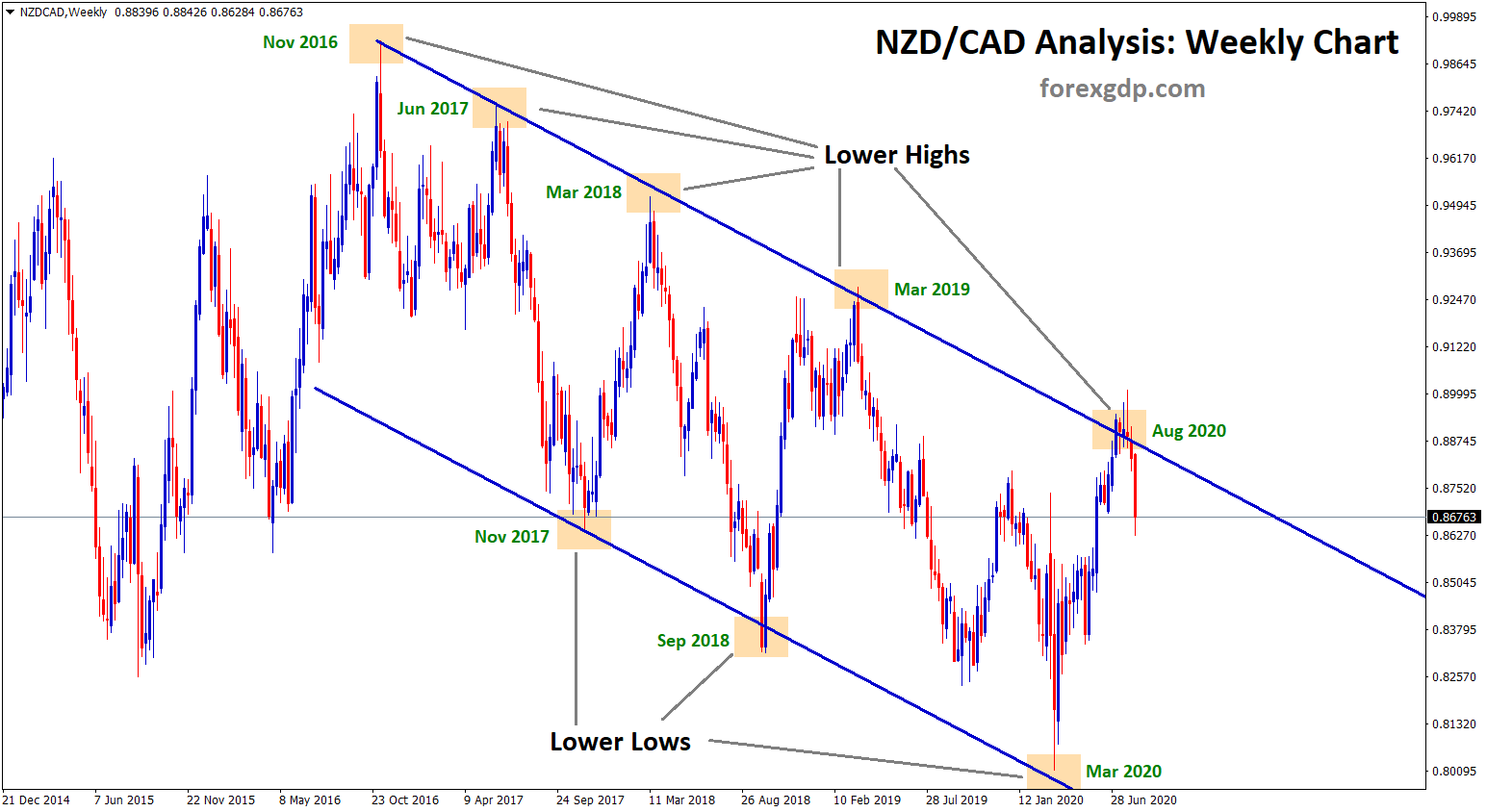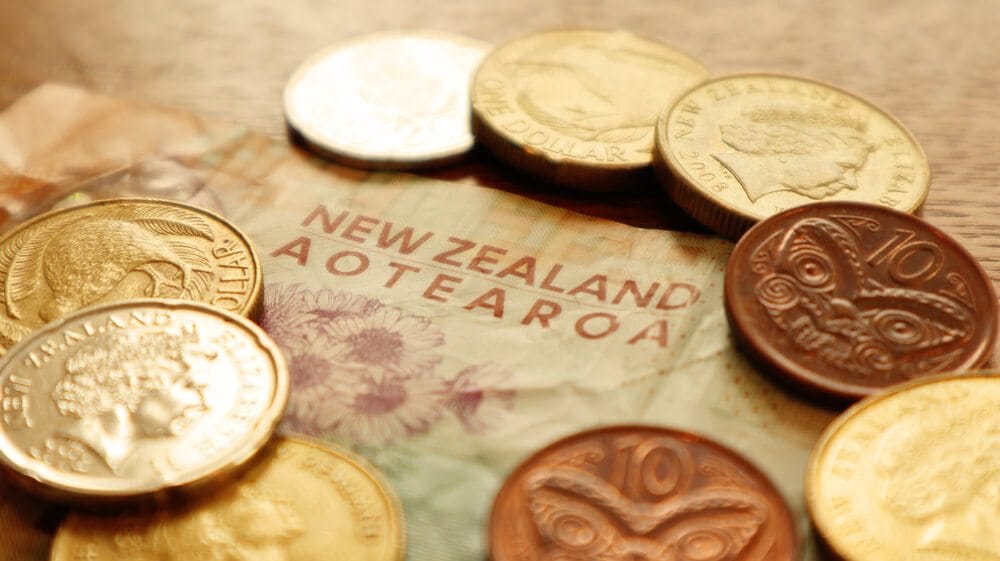Introducing NZDCAD
The New Zealand Dollar (NZD) and the Canadian Dollar (CAD) make up the NZDCAD currency pair. The NZD is New Zealand’s national currency, while the CAD is Canada’s national currency. The NZD is the world’s ninth most traded currency, while the CAD is the world’s sixth most traded currency. Together, the NZDCHF is the world’s eleventh most traded currency pair. The NZD is well-known because of its geographic position and a strong economy. The CAD is widely used because Canada is quite popular as being one of the friendliest states. Before we get into how to trade the NZDCAD currency pair, let’s first explore the historical significance of the New Zealand Dollar and Canadian Dollar.
The New Zealand Dollar
The New Zealand Dollar, abbreviated as NZD, was introduced in 1967. It is the world’s ninth most commonly used currency. Previously, the New Zealand Pound served as its currency. Until 1985, the New Zealand Dollar had a fixed exchange rate with the US Dollar. They were only permitted to use variable rates after 1985.
Their physical notes have undergone various changes throughout the years to make them more visually appealing while being more secure. New Zealand switched its banknotes from paper to polymer and plastic in 1999. This was done to make counterfeit notes easier to spot. This also makes the notes waterproof and harder to break. The printing on their notes is well-known for being incredibly colorful, and they are always updating the design to make it more appealing.
The Canadian Dollar
The maple country’s official currency is the Canadian dollar. In terms of trade volume, the Canadian Dollar is the sixth most widely used currency. Since 1841, Canada has used the Canadian Pound as its currency. This occurred during the reign of the British Empire. In contrast, the United States swiftly became the most desired currency, and the USD quickly exceeded all other currencies.
In order to strengthen links with the United States, Canada adopted the Canadian Dollar as its official currency in 1858. The Bank of Canada is in control of CAD note production. Canadians are well-known for their sense of humor and the energy they bring to the English language. They usually refer to their paper notes using the same expression. The $1 note is widely known as a ‘Loonie,’ while the $2 note is known as a ‘Toonie.’
Why Trade NZDCAD
Both New Zealand and Canada belong to two completely different regions of the world. This gives them a unique touch when placed together as a currency pair. Here is why you should trade the NZDCAD:
Cross-Currency Pair
One of the most compelling reasons to trade the NZDCAD pair is that it is a cross-currency. As a result, it may significantly expand the variety of assets with which you interact in this market. Trading the same major currency pairs over and again might become boring after a while. You’ll spend the entire day monitoring the same key trends. Trading a cross-currency pair is like visiting a new location for the first time. You’ll learn how markets function when the USD isn’t present. You’ll also be able to participate in cross-trades, which we’ll go over in more depth later.
Market Predictability
The market circumstances for NZDCAD are quite predictable. This is due to the fact that changes in their respective countries, New Zealand and Canada, have the greatest impact on them. Because the USD is the standard currency for international transactions, any changes anywhere in the world will have an impact on a pair that includes the USD. Similarly, changes in any of the European Union’s 28 member countries would have an impact on a pair that included the Euro. As a result, keeping track of every location that may have an impact on a currency pair becomes impractical. Currency pairs that are just tied to a certain region, such as NZDCAD, are much easier to research because we only need to evaluate their respective countries.
Market Correlations
The links between forex pairs like the NZDCAD and other market assets are strong reasons to trade them. This is demonstrated by the New Zealand Dollar, which has significant connections to commodities such as dairy goods and gold. These are the most popular exports from the country. It’s especially obvious in the case of the Canadian Dollar, which is heavily correlated with commodities like gold and crude oil. This is due to their involvement in the exportation of these pricey commodities. As a consequence, trading this pair becomes more easier since we can readily grasp the direction of the commodities market if we understand the direction of the NZDCAD market. Later, we’ll take a closer look at how these commodities will affect the movement of the NZDCAD currency pair.
NZDCAD Trading Tips
The NZDCAD can present some volatile market conditions at times. Therefore, it is crucial to have a trading strategy in place to benefit from these conditions. Here are some top trading tips for the NZDCAD currency pair:
Day Trading
Day trading is a trading method that involves opening and closing a trade on the same day. Before the market closes, all deals, whether profitable or not, must be completed. Scalping is a popular trading approach for this trading style. Traders would open a BUY and SELL position for the same currency pair at the same rate. This allows them to benefit regardless of how the market changes. When the market falls, they benefit from the opposing position they take. This method is ideal for the NZDCHF, as this volatile pair may be rather volatile at times. Day trading, particularly scalping, is an excellent approach for profiting from shifting market circumstances during times of volatility.
Range Trading
The practice of identifying when to enter a trade by studying support and resistance levels is known as range trading. The highest points on a particular chart are the resistance levels. Similarly, the lowest points on a particular chart represent levels of support. Understanding the location of these highs and lows is critical to the range trading approach. For instance, if the price is approaching a resistance level and you believe it will hold, you may place a SELL order. This is also known as going short. Similarly, if the price hits a level of support that you believe will be sustained, you may place a BUY order. Going long is another way of saying this.
Trend Trading
Trend trading is all about spotting patterns on trading charts and utilizing them to make trades. Detecting an uptrend and a downturn are two of the most prominent patterns that traders look for. These reflect bullish and bearish market circumstances, respectively. When the highs and lows both rise, the market is in an uptrend. When both the lows and highs fall, the market is in a downtrend. Because you can spot trend patterns merely by glancing at a chart, this is a fairly easy trading strategy that anyone can grasp. Because the NZDCAD is known for having extended upward and negative trends, this is an excellent approach for this currency pair.
Factors Affecting NZDCAD
Both New Zealand and Canada are impacted by very different reasons. Therefore, when placed together they present a whole variety of factors that could impact their markets. Here are some top factors impacting the NZDCAD currency pair:
The Tourism Industry
New Zealand is among some of the world’s most popular tourist destinations. Any changes in the number of visitors visiting New Zealand will have a considerable influence on the value of the NZD currency. If New Zealand faces an influx of tourists, the value of the NZD will increase which will cause NZDCAD to also increase in value. If New Zealand faces a quiet holiday season, the value of NZD will fall which will cause NZDCAD to also drop in value.
The Crude Oil Industry
Canada is a major crude oil exporter in the globe. Any variations in demand for this commodity have a substantial influence on the overall worth of the Canadian economy. If global demand for crude oil rises, Canada will be able to export it more often, boosting the Canadian dollar’s worth. As a result, the NZDCAD’s value would fall. Similarly, if global crude oil demand falls, Canada will be unable to export as much as usual, leading the CAD to decline in value. As a result, the NZDCAD’s value would climb.
The Dairy Industry
Any changes in the dairy industry will have a significant influence on the currency pair NZDCAD. This is because New Zealand is the world’s largest exporter of whole milk powder. Their economy is mostly driven by commodity demand. If the demand for these commodities rises, the NZDCAD will profit greatly.
Similarly, if demand for this commodity dips, the NZDCAD’s value falls as the New Zealand economy suffers. We may also look at it from a monetary standpoint. The value of NZDCAD would grow if the price of certain types of dairy products rose, while the value of NZDCAD would fall if the price fell.
The Gold Industry
Both New Zealand and Canada are among the largest exporters of valuable metals such as gold. Therefore any changes to the demand for gold around the world will have an impact on both the NZD and CAD. This may sometimes cause the impacts to cancel out each other when trading the NZDCAD currency pair.
If the demand for gold increases around the world, New Zealand will be able to export them more than usual which will cause NZD to increase in value. This will cause NZDCAD to also increase in value. Similarly, if the demand for gold increases around the world, Canada will also be able to export them more than usual which will cause CAD to increase in value. This will cause NZDCAD to drop in value
Financial Institutions
Both the Reserve Bank of New Zealand and the Bank of Canada are majorly responsible for any instability in the NZDCAD marketplace. The RBNZ and BOC release monthly reports and statements regarding updates to any policy changes. These reports also display the economic and monetary forecasts for the upcoming short-term.
Any positive results from the RBNZ will have a positive impact on the NZDCAD currency pair. However, any positive results from the BOC will have an inverse impact on the NZDCAD currency pair. The representatives of these individual banks also hold speeches frequently where they explain these results in more detail. These speeches are just, if not more, important in determining the direction of the NZDCAD market. From RBNZ, Adrian Orr who is the Governor of the institution is highly looked upon for his speeches. From BOC, Andrew Bailey who is the Governor of the institution is highly looked upon for his speeches.
Gross Domestic Product
GDP (Gross Domestic Product) has a significant impact on the volatility of this minor currency pair. GDP is a metric that measures a country’s total economic performance. A positive GDP figure indicates that the economy is prospering. This, in turn, would encourage individuals to invest in the country’s economy, increasing the currency’s worth.
If New Zealand’s GDP increases, the NZD will rise in value, causing the NZDCAD to rise as well. In the case of CAD, the reverse is true. If Canada announced a strong GDP, the CAD would rise, driving the NZDCAD to fall.
US Demand
The United States is Canada’s largest export market. Canada relies on steady US demand in order to profit from the selling of its commodities. Any changes in the US market for Canadian products will have a big influence on the worth of their economy. If there is a large demand for Canadian items in the US, the value of the CAD will rise. As a result, the value of the NZDCAD would fall. Similarly, if demand for Canadian goods in the US is lower than normal, the value of the CAD will fall. The NZDCAD’s value would rise as a result of this.
Most common questions asked by the forex traders about NZDCAD:
Forex GDP, Babypips, Tradingview, Forexfactory.
NZDCAD Trading Signals
Check Full Forex Market Signals with Technical Analysis Chart
Please note : It is better to do nothing instead of taking wrong trades, we focus on providing you the forex signals only at good trade setup.
Each trade signal given to you with fundamental and technical analysis chart which helps you to understand why our analyst team has given the Buy signals and Sell Signals. Now, you can trade with confident using our service. Sounds good? Let’s look out all our signal charts below.
If you want to test our forex signals, Try free plan (or) if you need more forex signals, Join here for Premium or Supreme plan
Check all our signal results and some of the subscriber’s Myfxbook results here. Try our free service now, let the results speak the rest.

A Reversal happening in Descending Channel of NZDCAD
NZDCAD Downtrend Analysis NZDCAD is moving in a downtrend forming lower highs, lower lows in Weekly Chart. A Clear Descending






